Even though it’s not always visible, sometimes our home plumbing needs as much love and care as the décor of our living room!

If the pipes under your sink or in your basement are dripping, serious damage could be done. Update your plumbing with PVC piping. Here we provide a PVC pipe 101 guide so you can successfully use PVC in residential plumbing applications.
Characteristics of PVC
If you need to upgrade the plumbing in your home, you should consider installing PVC piping. It is resistant to corrosion, making it ideal for drainage, and it’s easier to work with than steel or copper because it’s more lightweight. You may be surprised to learn that PVC is safe to use with water as long as the temperatures stay below 140°F. If you have applications where the temperature would be above this, you can install CPVC pipe. It’s similar to PVC except it has a slightly different chemical makeup, allowing it to handle temperatures up to 200°F. It’s no wonder PVC is a staple among home improvement projects. Not only does it have a long use life, it’s also less expensive than its counterparts, such as steel and copper piping.
PVC Pipe Sizes
PVC piping is a popular choice among homeowners because it comes in a variety of sizes, so no matter the project being tackled, everyone can find the pipe and fittings that are just right for them. If you’ve ever been confused about which type or size of PVC pipe you need, you’re not alone. However, this guide will hopefully make things clearer. There are two features PVC pipe and fittings are defined by: their wall thickness and the Nominal Pipe Size. The wall thickness of the pipe is considered the “schedule” of the pipe. You may have seen PVC described as Schedule 40 or Schedule 80. Schedule 40 PVC is typically white and used for residential plumbing. Schedule 80 PVC has a thicker wall and is usually gray in color. You probably will not have much need for Schedule 80 PVC in your home since it’s mostly used in commercial and industrial applications.
Nominal Pipe Size (NPS) can be even more confusing to understand because its pipe diameter measurement is not an exact measurement of the pipe’s diameter. For example, a ½” NPS pipe has an outside diameter of .84”. The important thing to note here is that if you use the same schedule of pipe throughout your entire project, the pipe and fittings of the same size will all fit together. For example, if you use a 1” Schedule 40 pipe, you can attach a 1” Schedule 40 elbow fitting or tee fitting or coupling to this pipe.
Cutting and Gluing PVC
Before cutting or gluing PVC pieces together, it’s important to note that you can’t unglue PVC. The glue (or cement) chemically changes the composition of the pipe, essentially melting the pipe and fitting together. Once the adhesive hardens (which happens fast), the pipe and fitting cannot be pulled apart. Because the connections are essentially permanent (unless you’re willing to cut the pipe again and make a new connection with a new fitting), follow these tips when cutting and gluing PVC:
Measure and Measure Again
You can never measure too many times. Before making any cuts, take careful measurements. And then do it again.
Use the Right Tool
When you’re ready to make the first cut, make sure you have the right tool on hand. For small projects, you can use a hacksaw. For larger projects, you’ll want to use a PVC cutter or an electric miter saw, both of which will make your cuts precise and quick.
Sand the Rough Edges
Before gluing your PVC pieces together, sand or file down any rough edges on the ends of your pipe. Make sure to clean out the burrs on the inside of the pipe as well as on the outside.
Dry Fit Your PVC
When working with PVC pipes, it’s always best to dry fit all the pieces together before introducing adhesives. This will help you know if you need to file edges any more or if you cut a PVC pipe too short. Once everything seems right, mark the piping and fittings with a marker to ensure proper alignment once you fit the pieces back together with an adhesive.
Glue PVC Pipe and Fittings
As we mentioned earlier, PVC cement fuses the pipe and fittings together. For this reason, it’s important to work quickly and to focus on one section at a time. If your application needs to be water-tight, use PVC primer before gluing.
Understanding Fittings
Tees, elbows, and couplings—Oh my! When it comes to residential plumbing, it may be necessary to snake the piping around corners or obstacles. Thankfully, with PVC, there are plenty of fitting types to get the job done. For your residential plumbing project, you’ll probably need PVC tees, elbows, and crosses. However, couplings, unions, caps, and plugs may also be necessary. The good news is that all these pieces are extremely affordable, especially if you shop online. If your project can wait, it’s always a good idea to comparison shop in stores and online before purchasing all your materials.
PVC fittings come with a variety of end types. Typically, these fittings have slip ends, which means the fitting slips over the pipe and does not have threads to hold it in place. Therefore, primer and cement are needed to make this connection watertight. Other fittings have threaded ends because the connections are not meant to be permanent. Instead of cement, the connection between these types of fittings can be reinforced with PTFE thread seal tape. For your plumbing project, you’ll most likely need fittings with slip ends.
Using PVC Piping in Residential Plumbing
Home remodeling can be expensive but is often necessary. Using PVC for plumbing projects is a great way to stay within a budget because it’s inexpensive and doesn’t require many supplies. We hope this PVC pipe 101 guide helps you understand the benefits of using PVC piping in your home plumbing.
Author Byline:
Mark Ligon is the Marketing Manager at PVC Fittings Online, a leading supplier of consumer-based plumbing supplies, including piping, fittings, valves, plumbing supplies, and accessories. Mark is a DIYer and provides advice to individuals on DIY projects utilizing a range of PVC type products.

No comments:
Post a Comment